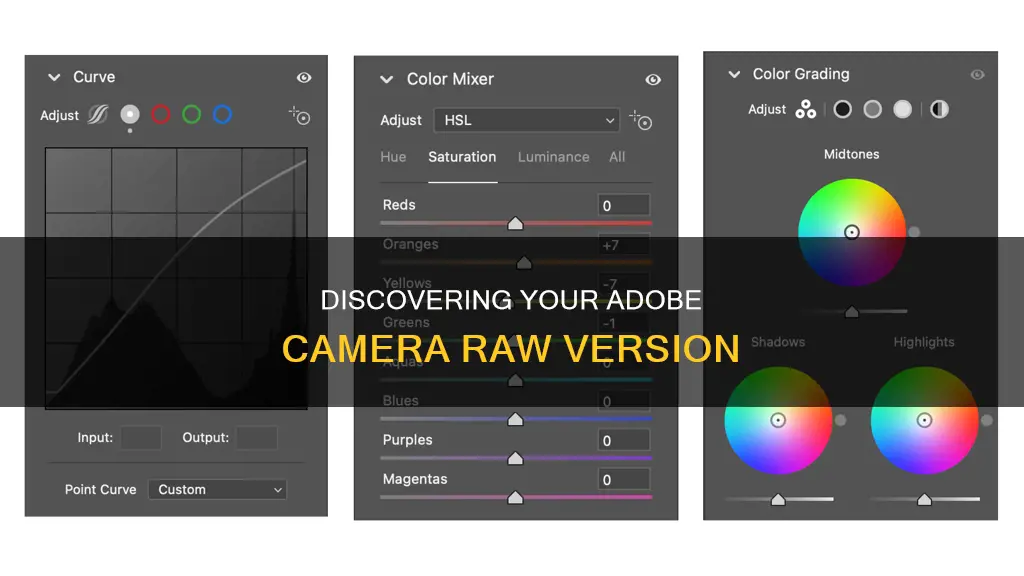
Adobe Camera Raw is a powerful tool for photographers, allowing them to import and enhance raw images. It has been frequently updated since its release in 2003 and is available as a plug-in for various Adobe applications, including Photoshop, Lightroom Classic, Lightroom, Photoshop Elements, After Effects, and Bridge. The latest version of Adobe Camera Raw as of August 2024 is 16.5, which supports new cameras, lenses, and bug fixes. To check which version of Adobe Camera Raw you have, you can refer to the Adobe application compatibility table, which lists the Camera Raw version included with each application and the latest supported version.
| Characteristics | Values |
|---|---|
| Date of Last Update | August 14, 2024 |
| Latest Version | 16.5 |
| Previous Versions | 16.3, 16.0, 15.3, 15.0, 14.5, 11.0, 10.5, 9.12.1, 9.1.1 |
| Installer File Type | zip, exe, dmg, pkg |
| Compatible Adobe Applications | After Effects, Bridge, Photoshop, Photoshop Elements, Photoshop Elements Editor, Premiere Elements, Premiere Elements Editor, Lightroom, Lightroom Classic |
| Supported Camera Models | Apple, Canon, Casio, Contax, DJI, DxO, Epson, Fujifilm, Google, GoPro, Hasselblad, Huawei, Kodak, Konica Minolta, Leaf, Leica, LG, Mamiya, Motorola, Nikon, Nokia, OM Digital Solutions, OnePlus, Olympus, Panasonic, Parrot, Pentax, PhaseOne, Pixii, Ricoh, Samsung, Sigma, Skydio, Sony, Xiaomi, Yuneec, Zeiss |
| Supported Image Formats | Bayer and X-Trans mosaic raw files |
What You'll Learn

How to update Adobe Camera Raw
To update Adobe Camera Raw, follow these steps:
For Windows:
- Exit all Adobe applications.
- Double-click the downloaded .zip file to unzip it. Windows may unzip the file for you.
- Double-click the resulting .exe file to initiate the installation process.
- Follow the on-screen instructions.
- Restart your Adobe applications.
For macOS:
- Close all Adobe applications.
- Click the downloaded .dmg file. In the case of Camera Raw 10.5, double-click the .zip file to unzip it.
- Double-click the .pkg file to start the installation.
- Follow the on-screen instructions.
- Restart your Adobe applications.
You can also update Adobe Camera Raw by launching Photoshop and choosing Help > Updates.
The current version of Adobe Camera Raw is 16.5, released in August 2024. It includes support for new cameras, lenses, and bug fixes.
Unsticking Camera Battery Acid: A Step-by-Step Guide
You may want to see also

Adobe Camera Raw system requirements
To run and use Adobe Camera Raw, your computer must meet the minimum technical specifications. These specifications vary depending on the version of Adobe Camera Raw you are using.
October 2023 release (version 16.0) and later:
Minimum system requirements:
- Intel® or AMD processor (2 GHz or faster with SSE 4.2 or later, and 64-bit support), or ARM processor (2 GHz or faster with 64-bit support)
- Windows 10 (version v22H2 or later) or Windows 11 (version 21H2 or later)
- 4 GB of available hard-disk space; additional space required for installation
- 1024 x 768 display at 100% UI scaling
- 1920 x 1080 display at 100% UI scaling
Graphics card (GPU) requirements:
- GPU with DirectX 12 support
- 4 GB of GPU memory for 4k displays and greater
- 8 GB of dedicated GPU memory or 16 GB of shared memory for full GPU acceleration
For macOS:
- Multicore Intel® processor (2 GHz or faster with SSE 4.2 or later, and 64-bit support) or Apple M1 or later processor
- MacOS Monterey (version 12) or later
- 4 GB of available hard-disk space; additional free space is required during installation
- 1920 x 1080 display or greater
Graphics card (GPU) requirements:
- GPU with Metal support
- 4 GB of GPU memory for 4k displays and greater
- 8 GB of dedicated GPU memory or 16 GB of shared memory for full GPU acceleration
Earlier releases:
Minimum system requirements:
- Intel Core 2 or AMD Athlon 64 processor; 2 GHz or faster processor
- Windows 7 with Service Pack 1, Windows 8.1, or Windows 10
- 2 GB or more of RAM (8 GB recommended)
- 1024 x 768 display (1280x800 recommended) with 16-bit color
- OpenGL 3.3 and 1 GB or more of Video RAM (VRAM) for GPU-related functionality (2 GB of dedicated VRAM is suggested for large, high-resolution monitors, such as 4K- and 5K-resolution monitors)
Graphics processor acceleration requirements:
- AMD: Radeon GPU with DirectX 12 or OpenGL 3.3 support
- Intel: Skylake or newer GPU with DirectX 12 support
- NVIDIA: GPU with DirectX 12 or OpenGL 3.3 support
- 1 GB of Video RAM (VRAM). 2 GB of dedicated VRAM (4 GB recommended) for large, high-resolution monitors, such as 4K- and 5K-resolution monitors
For macOS:
- Multicore Intel processor with 64-bit support
- MacOS 10.11 (El Capitan), 10.12 (Sierra), 10.13 (High Sierra)
- 2 GB or more of RAM (8 GB recommended)
- 1024 x 768 display (1280x800 recommended) with 16-bit color
- OpenGL 3.3 and 1 GB or more of Video RAM (VRAM) for GPU-related functionality (2 GB of dedicated VRAM is suggested for large, high-resolution monitors, such as 4K- and 5K-resolution monitors)
Graphics processor acceleration requirements:
- AMD: macOS 10.12 with Metal support
- Intel: macOS 10.12 with Metal support
- NVIDIA: macOS 10.12 with Metal support, or macOS 10.11 with OpenGL support
- 1 GB of Video RAM (VRAM). 2 GB of dedicated VRAM (4 GB recommended) for large, high-resolution monitors, such as 4K- and 5K-resolution monitors
Adobe Camera Raw plug-in:
The Adobe Camera Raw plug-in allows you to import and work with raw images, as well as JPEG and TIFF, in Photoshop. Your computer may need to meet additional system requirements to work efficiently with this plug-in.
Supported cameras:
Adobe Camera Raw supports raw images from many different cameras, including iPhone, iPad, Google Pixel, Samsung Galaxy, Nikon, and Canon models. The supported cameras are listed on the Adobe website.
Rechargeable Camera Batteries: Do They Have an Expiry?
You may want to see also

Adobe Camera Raw compatible applications
Adobe Camera Raw is a powerful tool for photographers and graphic designers who work with raw image files. It is a plugin that allows users to process and edit raw image files from digital cameras. It offers a wide range of tools and features to enhance, adjust, and fine-tune raw images, ensuring they reach their full potential in terms of colour, exposure, and detail.
Adobe Camera Raw is compatible with and can be used in conjunction with several Adobe applications, including:
- Photoshop: Adobe Camera Raw is accessible through the "Filter" > "Camera Raw Filter" option in Photoshop. It allows users to edit and enhance raw images directly within Photoshop, providing greater artistic control and flexibility while maintaining the original files.
- Photoshop Elements: Photoshop Elements users can utilise Adobe Camera Raw to import and enhance raw images, benefiting from its extensive editing capabilities.
- After Effects: The After Effects application is compatible with Adobe Camera Raw, allowing users to incorporate the plugin's functionalities into their workflow.
- Bridge: Bridge users can also take advantage of Adobe Camera Raw to work with raw image files, leveraging its features for importing and enhancing their photographs.
- Lightroom: While not explicitly mentioned in the sources, it is important to note that Adobe Lightroom is built upon the same powerful raw image processing technology that powers Adobe Camera Raw. This suggests a level of compatibility and integration between the two applications.
It is worth noting that to use Adobe Camera Raw, you need to have either Adobe Photoshop or Adobe Lightroom installed on your computer. Once either of these software applications is installed, Adobe Camera Raw is automatically available as a plugin, and no separate installation is required.
The Power of Charge-Coupled Cameras: Capturing Light, Creating Images
You may want to see also

Adobe Camera Raw file formats
A camera raw file contains unprocessed or minimally processed data from the image sensor of a digital camera, motion picture film scanner, or other image scanner. Raw files are so named because they are not yet processed and contain large amounts of potentially redundant data. They are sometimes incorrectly described as "digital negatives".
Raw image files contain the information required to produce a viewable image from the camera's sensor data. The structure of raw files often follows a common pattern:
- A short file header which typically contains an indicator of the byte-ordering of the file, a file identifier, and an offset into the main file data.
- Camera sensor metadata which is required to interpret the sensor image data, including the size of the sensor, the attributes of the CFA and its colour profile.
- Image metadata which can be useful for inclusion in any CMS environment or database. These include the exposure settings, camera/scanner/lens model, date (and, optionally, place) of shoot/scan, authoring information, and other details. Some raw files contain a standardised metadata section with data in Exif format.
There are dozens of raw formats in use by different manufacturers of digital image capture equipment. Many raw file formats are based on TIFF, the Tag Image File Format. These include IIQ (Phase One), 3FR (Hasselblad), DCR, K25, KDC (Kodak), CRW, CR2, CR3 (Canon), ERF (Epson), MEF (Mamiya), MOS (Leaf), NEF NRW (Nikon), ORF (Olympus), PEF (Pentax), RW2 (Panasonic), and ARW, SRF, SR2 (Sony).
Adobe's Camera Raw software supports raw files in the Digital Negative (DNG) format, a non-proprietary, publicly documented, and widely supported format for storing raw camera data. It is an extension of the TIFF 6.0 format and is compatible with TIFF/EP, using various open formats and/or standards, including Exif metadata, XMP metadata, IPTC metadata, CIE XYZ coordinates, ICC profiles, and JPEG.
DNG is the only raw image format for which industry-wide buy-in is being sought. It has been adopted by several "niche" camera manufacturers, including Leica, Samsung, Ricoh, Pentax, and Hasselblad, and is used by most Canon point-and-shoot cameras.
Panasonic Lumix DMC-LX10K: Battery Life Explained
You may want to see also

Adobe Camera Raw troubleshooting
Adobe Camera Raw is a tool that lets you import and enhance raw images. It supports raw files in the Digital Negative (DNG) format, which is a raw file format made available to the public by Adobe. Applications that support Adobe Camera Raw include Photoshop, Photoshop Elements, After Effects, and Bridge.
To check what version of Adobe Camera Raw you have, you can refer to the version history on the official Adobe website. As of August 2024, the latest version of Adobe Camera Raw is 16.5.
- If you are experiencing issues with the Camera Raw plug-in for Adobe applications, try updating to the latest version of the plug-in, which is currently Camera Raw 16.5.
- If you are using older Adobe applications that are no longer supported, you can use the Camera Raw 14.5 installer.
- For issues with specific camera models or lenses, check the list of supported cameras and lenses on the Adobe website. Adobe Camera Raw frequently updates its supported camera models and lenses, so make sure you have the latest version of the software.
- If you are encountering bugs or errors when using Adobe Camera Raw, check the release notes for the software version you are using. Adobe regularly releases updates that fix known issues and improve compatibility with new cameras and lenses.
- Some common issues that have been addressed in recent updates include saving images resulting in an unknown error, lens profile mismatches, white lines appearing in photos, and issues with importing specific file formats.
Best Long-Lasting Camera Batteries: Power Your Photography
You may want to see also
Frequently asked questions
To check which version of Adobe Camera Raw you have, you can refer to the Camera Raw plug-in and Adobe application compatibility table on the official Adobe website. This table lists the Adobe applications that are compatible with the Camera Raw plug-in, along with the corresponding Camera Raw version.
To update your Adobe Camera Raw version, first, check that you have exited all Adobe applications. Then, download the appropriate file for your operating system and follow the installation instructions. Finally, restart your Adobe applications.
Updating your Adobe Camera Raw version can provide several benefits, including support for new camera models, improved features, and bug fixes. For example, the August 2024 release of Adobe Camera Raw (version 16.5) added support for new cameras and lenses, while also addressing various bugs.







